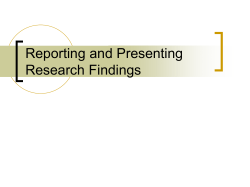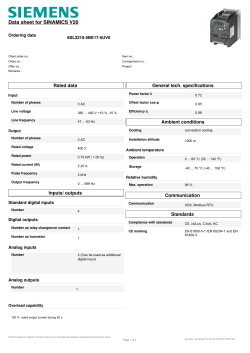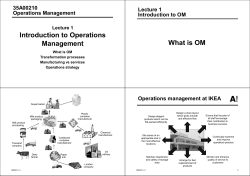
-- or how to make your organization hum with numbers..
Collaborating for a Change: A Statewide Probation Work Session HOW TO USE DATA IN ORGANIZATIONS -- or how to make your organization hum with numbers.. Sacramento, CA October, 2011 Charlene Rhyne, PhD CJI Consultant WHY ARE YOU HERE? • I love numbers • My boss is a data geek • My Chief wants everyone to work with numbers • The State is moving in this new direction 2 CONGRATULATIONS • Learning organization • Using data to ensure growth – Accuracy – Adherence – Achievement • Evidence-based principle – Measure relevant processes and practices – Provide measurement feedback 3 EVIDENCE BASED PRINCIPLES • 1. Assess risk/needs • 2. Enhance intrinsic motivation • 3. Target Interventions • 4. Skill train with directed practice • 5. Increase positive reinforcement • 6. Engage ongoing support in natural communities • 7. Measure relevant processes and practices • 8. Provide measurement feedback 4 WHAT WE WILL TALK ABOUT TODAY? • How to get started? • Where does the data come from? • Big picture • Drilling down • On-going monitoring 5 QA vs CQI CONTINUOUS QUALITY IMPROVEMENT QUALITY ASSURANCE Tends to focus on finding who is responsible for errors Internally driven, empowers all personnel to make improvements • Relies on inspections to identify errors Focuses on improving the system • Seeks to prevent errors by continuously clarifying and improving processes • Continuously strives to improve quality • Management/leadership is shared governance model Driven by regulatory and accrediting agencies • • 6 • • • Periodically monitors quality • Management/leadership is top-to-bottom GETTING STARTED • Feeling overwhelmed? • Find a champion • Convene a data committee • Create a logic model 7 WHAT IS A LOGIC MODEL? INPUTS ACTIVITES OUTPUTS OUTCOMES • Story board of the work you are doing • Logical relationships between resources invested, activities that take place and changes that occur • Used in program planning, evaluation, management, communications and measurement • Start with a simple process flow diagram 8 INPUTS INPUTS ACTIVITES • What we invest • • • • 9 OUTPUTS Staff Expertise Money Materials OUTCOMES ACTIVITIES INPUTS ACTIVITES OUTPUTS OUTCOMES • Actions taken to accomplish outcomes • • • • 10 Assessments Case planning Referrals Sanctions OUTPUTS INPUTS ACTIVITES OUTPUTS OUTCOMES • What we get by doing the activities • % of high and medium risked probationers with an assessment within 60 days of intake • % of high and medium risked probationers with a case plan within 60 days of assessment • % of referrals that target top 4 criminogenic needs 11 OUTCOMES INPUTS • ACTIVITES OUTPUTS Results or changes for individuals, groups, communities, organizations, systems • Outcomes can be: • Short term • Intermediate • Long term 12 OUTCOMES BENEFITS – or why are we doing all this work? • Why this logic model thing? – Provide a framework to focus our work – Provides a common language – Helps us differentiate between ‘what we do’ and ‘results’ – Creates understanding – A way of thinking – not just a pretty picture 13 FINAL PRODUCT OUTCOMES INPUTS ACTIVITIES OFFICERS ASSESSING TRAINING CASE PLANNING ASSESSME REFERRALS NT TOOLS 14 OUTPUTS SHORT LONG % OF ASSESSMENTS COMPLETED ON TIME % OF MED AND HIGH RISK CLIENTS WITH AT LEAST ONE OF CRIMINOGENIC NEEDS ADDRESSED IN CASEPLAN COMMUNITY SAFETY % OF CASE PLANS COMPLETED ON TIME % OF REFERRED CLIENTS ENTERING TX % OF TARGET NEEDS REFERRED TO TX WHERE DO YOU GET THE DATA? • Electronic case management system • Case file reviews • Observations • Taping • Spreadsheets • Satisfaction Surveys • IT • R&E 15 WHAT HAPPENS IF YOU DON’T MEASURE? • How do you know: • If you are improving or declining? • How you compare with others? • Where are cost-effective results being produced? • Where to improve? • Where to distribute resources? • Are you achieving your mission and vision? 16 WHAT IS CQI? • Ensure that we are meeting our goals – EBP? – How well? – Improved outcomes • Commitment to improve services • Creating an appetite for data results in quality services 17 CORE CONCEPTS OF CQI • Quality defined • Success achieved • Most problems are found in processes, not in people • Variation in processes can lead to unwanted variation in outcomes • It is possible to achieve continual improvement • Continuous improvement is effective » 18 http://www.fpm.iastate.edu/worldclass/ Develop CQI policies and procedures PDSA PLAN Implement changes; corrective action ACT EVIDENCE BASED PRACTICE DO Conduct reg reviews through the creation of reports using obj and measurable performance objectives Feedback mechanism: bring in CJM, stakeholders for review 19 STUDY DATA DISCUSSION • Who? • What? • How? 20 DO’S & DON’TS DO • • • • • • • • • 21 Empower staff Time to meet goals Let manager review Focus on strengths, affirmations and praise Expect results Focus on teamwork Accountability for outcomes under influence Learn from others Use behavior change principles DON’T • • • • • • Play power games Ignore lack of effort Let meetings become dreary Focus on minutia Allow excuses Allow blaming others DATA REVIEW PROCESS OVERALL DEPT UNIT PPO 22 UNIT PPO PPO START AT THE TOP • Department-wide Percent of Assessments Completed In A Timely Manner BENCHMARK = 85% 75% 1st QTR 23 82% 85% 74% 2nd QTR 3RD QTR 4TH QTR DRILL DOWN • Unit Level: Percent of assessments completed in a timely manner** 3RD QTR 4TH QTR Generic Unit A 96% 90% Generic Unit B 88% 76% Gang Unit 65% 62% Domestic Violence 90% 72% Sex Offenders 85% 70% 85% 74% UNIT Overall total ** Benchmark =85% 24 DRILL DOWN • PO level: Percent of assessments completed in a timely manner** 3RD QTR 4TH QTR Paul Jones 96% 85% Sally Wilkes 88% 70% Nancy Smith 87% 62% Andrew Duran 92% 72% Cynthia Young 86% 70% 90% 72% OFFICER/DV UNIT Overall total ** Benchmark =85% 25 STREAMLINING CQI • Coordinate CQI plan development with workplan development • Automate measurement whenever possible • Collect and review multiple data elements at all times • Develop a dashboard of key measures • Prioritize measures on an annual basis 26 KEY INGREDIENTS: MAINTAINING YOUR SANITY • Remember to keep your sense of humor • If you do not have a sense of humor, develop one • Reward small gains • Recognize high achievers • Talk to other jurisdictions • Remember this is about the journey, not the destination • This process is on-going, iterative and evolutionary 27 THE NEVER ENDING JOURNEY • What do you always take on your travels? 28 QUESTIONS? • CONTACT INFORMATION: charlene.e.rhyne@multco.us Charlene Rhyne, MSW, PhD Manager, Quality Systems & Evaluation Services Multnomah County Dept. of Community Justice 501 SE Hawthorne Blvd. Suite 250 Portland, OR 97214 503.988.4126 29
© Copyright 2025





















